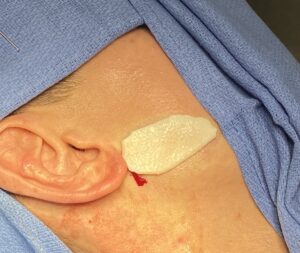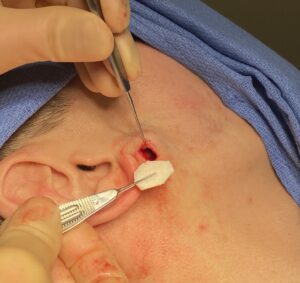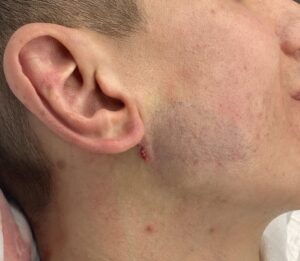Background: Augmentation of the jaw angles can be done by injectable therapies or implants. The advantage of implants is their permanency and improved control of the final jaw angle shape. Like all aesthetic implants their main disadvantages the risk of infection, implant malposition and the recovery. But one aesthetic disadvantage not frequently mentioned is the risk of masseteric muscle dehiscence with the placement of an implant underneath the muscle. It is undoubtably under reported since it has no functional significance being a soft tissue contour deformity only and is most significantly seen when biting, chewing or in large mouth opening. It also comes in varying degrees of involvement . Some patients have a touch of it and really don’t notice it while on the opposite side of the spectrum it can create a more major contour issue.
There are numerous contouring treatments for postoperative masseteric muscle dehiscence to eliminate the reveal of the implant. Injectables (synthetic fillers and fat), soft tissue grafts and implants as well as muscle repositioning are all viable treatment options. While muscle relocation is the ideal anatomic choice it requires an external incision and has a low rate of success. As a result camouflage approaches to build up the soft tissue contour deformity are more frequently used.
In soft tissue augmentation of the masseteric muscle deformity the decision as to which approach is best depends on its size, how long the muscle retraction has existed, the patient’s tolerance for scars and how much effort they want to put into it. In thin patients with little subcutaneous fat soft tissue grafting is a logical approach and then the decision is what would be the graft source.




Alloderm, which is cadaveric dermis, is a soft supple graft material that has decades of use as a soft tissue augmentation/contouring material. It gets incorporated into surrounding tissues and does not resorb in my experience particularly as a thick graft. Its suppleness is good as a contouring material but it can be challenging to ensure that it lays completely flatten the elevated soft tissue pocket with no folded edges. This is easier done in thicker Alloderm grafts than thinner ones.
Case Highlights:
1) Masseteric muscle retraction has a higher risk in jaw angle implant augmentation when vertical lengthening is needed particularly in the congenital asymmetry patient.
2) In the thin patient implant reveal/masseteric muscle retraction can cause a significant concave soft tissue contour deformity.
3) When implant size increases at the chin exceed what the tissues may safely be able to tolerate it needs to be changed to a bony genioplasty combined with a jawline implant that fits around it.
Dr. Barry Eppley
World-Renowned Plastic Surgeon


